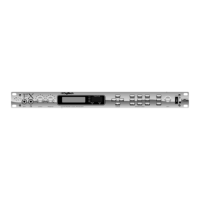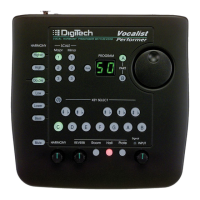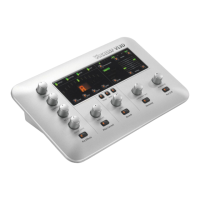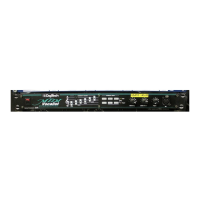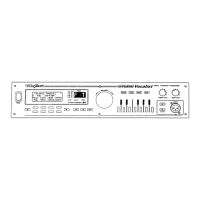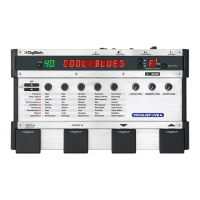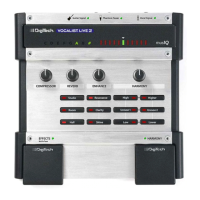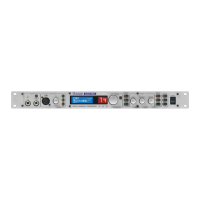
Do you have a question about the DigiTech VHM5 and is the answer not in the manual?
| Brand | DigiTech |
|---|---|
| Model | VHM5 |
| Category | Computer Hardware |
| Language | English |
Covers risk of shock, user servicing, and proper usage instructions for the device.
Explains registration, coverage period, limitations, and exclusions for product warranty.
Lists core functionalities including 5-part harmonies, LCD display, keyboard, effects, and MIDI.
Provides technical data such as S/N, THD, sampling rate, bandwidth, inputs, outputs, and connections.
Details LEDs, Signal Lock, Input/Output Level controls, and various operational buttons.
Explains the function of the Keyboard and Variation buttons for choosing harmonies.
Details AC power, MIDI In/Out/Thru, and Footswitch connections on the rear panel.
Covers Mic In, Line In, Line Out, Left Out, Right Out, and Headphone jacks.
Guides users on connecting the device, adjusting levels, and ensuring signal quality.
Describes Scalic Harmony, Chordal Harmony, Pitch Correction, Vocoder, Chorus/Detune, and Special Effects.
Provides instructions on hooking up microphones, effects, and mixers for operation.
Explains how to set input, vocal, and effect sliders for optimal audio levels.
Discusses mic placement and the Signal Lock LED for optimal input signal quality.
Details how to choose presets and change harmony types using buttons and the LCD.
Explains how to use the internal synth for pitch reference and tuning.
Describes how to move through menus using Parameter buttons and edit values.
Illustrates the menu structure and navigation paths for system settings.
Demonstrates Scalic harmony application with the "Happy Birthday" song example.
Explains how to use chordal harmonies with chord recognition features.
Details how to record and step through chord changes for songs using a list.
Guides through creating a song list step-by-step for a specific song.
Explains how to connect and use the FS 300 footswitch for program and bypass control.
Describes saving and editing individual entries within a song list.
Guides on connecting MIDI keyboards and other devices for controlling the Vocalist.
Explains how to use MIDI to select Vocalist programs and settings.
Lists factory programs categorized by function (e.g., First Impressions, Chordal).
Describes the first 16 programs for an overview of Vocalist capabilities.
Explains the naming convention for chordal harmony voicings and their structure.
Describes the Vocoder and Pitch Correct features and their operation.
Explains how Scalic programs generate harmonies based on scales and keys.
Covers enabling the synth for cue-in notes and adjusting the tuning reference.
Details basic MIDI channel and program change settings for communication.
Explains settings for Key Change and Program Change transmission/reception.
Describes how to save or transfer programs via MIDI for backup or sharing.
Explains how to assign MIDI controllers to Vocalist parameters for remote control.
Details adjusting sensitivity for sibilant sounds and gating harmonies for cleaner output.
Provides a visual map of the utility menu structure for system settings.
Describes editing program and variation titles, and redefining custom harmonies.
Details adjusting pitch detuning for chorus effects and harmony output levels.
Explains how to add vibrato and portamento to harmony parts for expressiveness.
Covers resetting programs to default and configuring footswitch bypass modes.
Details pitch randomization for humanization and portamento speed/attack/release.
Explains how to load factory harmonies and save custom variations.
Covers scale type, voicing, and key selection for creating Scalic harmonies.
Details chordal harmony voicings and common chord types used.
Explains the Vocoder feature, its modes, pitch bend, and transpose functions.
Covers pitch correction methods and MIDI keyboard splitting for control.
Explains how to name programs and variations for easier identification.
Describes how to edit individual harmony notes for each input note.
Details changing, inserting, and deleting entries within a song list.
Explains scales, keys, and their role in constructing Scalic harmonies.
Presents a scale chart and demonstrates harmony effects on non-scale tones.
Explains how the Vocalist handles notes not within the selected scale using 'n/c' or 'slur'.
Describes how the Vocalist interprets chords from a MIDI keyboard for harmony selection.
Details chord types and how harmony notes are selected relative to them.
Explains how vibrato and portamento affect harmony parts for expressiveness.
Guides on connecting MIDI keyboards and other devices for controlling the Vocalist.
Explains how to change Vocalist programs and settings using MIDI messages.
Details how MIDI Program Change messages map to selecting harmony variations and keys.
Explains how MIDI notes can select harmony variations and keys based on note number.
Describes how the Vocalist recognizes MIDI chords to select appropriate harmonies.
Explains how to define keyboard regions for controlling harmonies with MIDI.
Defines technical terms used in the manual such as LCD, MIDI, and No Change.
Defines various operational parameters like Pitch Bend and Pitch Correct.
Defines scale types and the Signal Lock indicator function.
Continues definitions including Voicing, Vibrato, Vocoder, and MIDI.
Defines parameters, scale types, and the 'Slur' function for harmony slides.
Defines Song List structure and the 'Store' button for saving changes.
Explains synth tone generation, transposing, and accessing utility functions.
Details the four available harmony variations and their voicings.
Details MIDI message handling for various functions like Note Number and Program Change.
